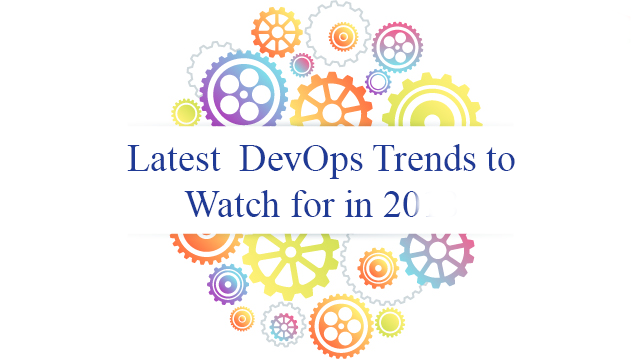DevOps Tools, CI/CD, Testing and Latest Trends
Reading Time: 11 Minutes
What is DevOps?
DevOps is a Modern software engineering Culture and Practices to develop a software where the development and operation teams work hand in hand as one unit, unlike the traditional ways, i.e., Agile Methodology where they worked individually to develop software or provide required services.
The traditional methods before DevOps were time-consuming and lacked understanding between different departments of Software Development, which lead to more time for updates and to fix bugs, therefore ultimately leading to customer dissatisfaction. Even to make a small change, the developer has to change the software from the beginning.
That’s why we are adopting such a culture, which allows fast, efficient, reliable software delivery through production.
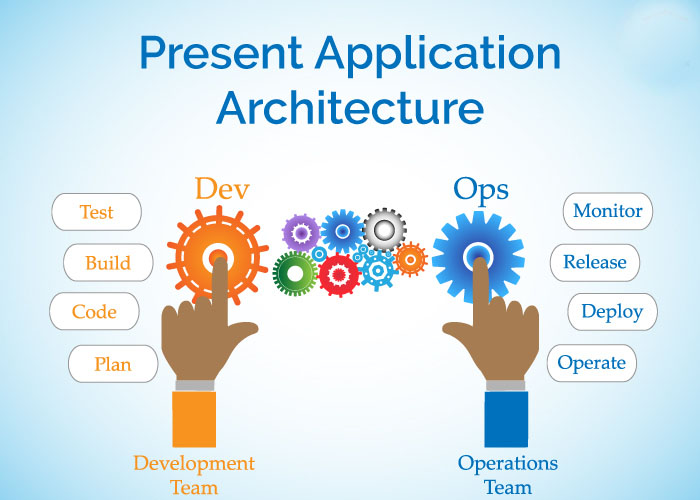
Business Benefits of DevOps
-
Maximize speed of delivery of the product.
-
Enhanced customer experience.
-
Increased time to value.
-
Enables fast flow of planned work into production.
-
Use Automated tools at each level.
-
More stable operating environments.
-
Improved communication and collaboration.
-
More time to innovate.
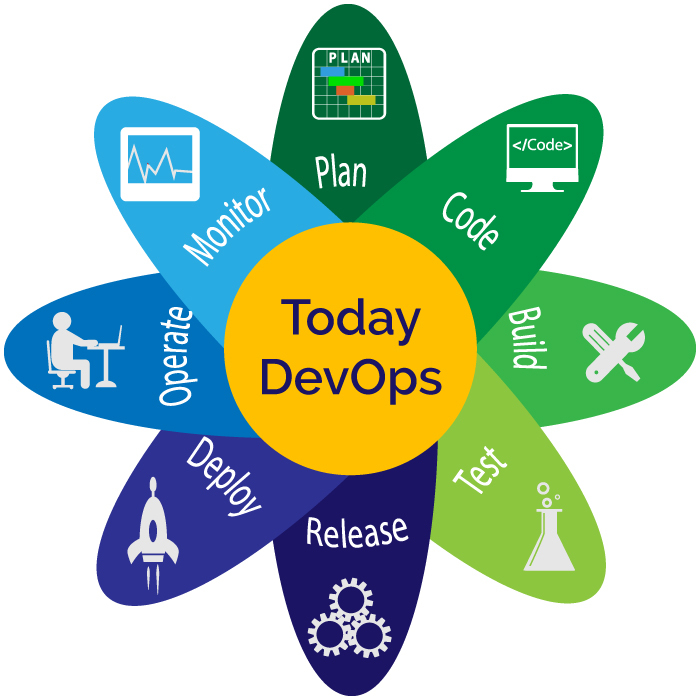
You May also Love to Read How To Adopt DevOps in Your Organization
6 Cs of DevOps Adoption
DevOps practices lead to high productivity, minor bugs, improved communication, enhanced quality, faster resolution of problems, more reliability, better and timely delivery of software.
-
Continuous Integration
-
Continuous Testing
-
Continuous Delivery
-
Continuous Deployment
-
Continuous Monitoring
-
Continuous Business Planning
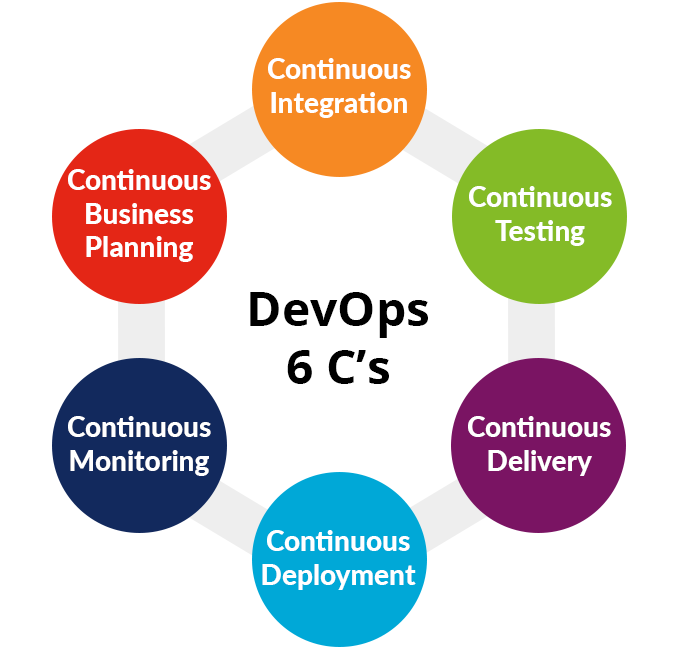
Continuous Integration
Continuous Integration means isolated changes are tested and reported when they are added to a larger code base. The goal of continuous integration is to give rapid feedback so that any defect can be identified and corrected as soon as possible.
Jenkins is used for continuous integration which follows 3 step rule, i.e., build, test and deploy. Here developer does frequent changes to the source code in shared repository several times a day.
Along with Jenkins, we have more tools too, i.e., BuildBot, Travis etc. Jenkins widely used because it provides plugins for testing, reporting, notification, deployment etc.
Continuous Testing
Continuous Testing is done to obtain immediate feedback on the business risk associated with Software Release. It's challenging and essential part of the software. Software rating depends upon Testing. Test function helps the developer to balance the quality and speed. Automated tools are used for testing as it is easier to do testing continuously instead of testing a whole software. The tool used for testing the software is Selenium.
Continuous Delivery
Continuous Delivery is the ability to do changes like including new features, configuration management, fixes bugs and experiments into production. Our motive for doing continuous delivery is the continuous daily improvement. If there is an error in the production code, we can quickly fix it that time. So, here we are developing and deploying our application rapidly, reliably and repeatedly with minimum overhead.
Continuous Deployment
The code is automatically deployed to the production environment as it passes through all the test cases. Continuous versioning ensures that multiple versions of the code are available at proper places. Here every changed code is put into production that automatically resulting in many deployments in production environment every day.
Continuous Monitoring
Continuous Monitoring is a reporting tool because of which developers and testers understand the performance and availability of their application, even before it is deployed to operations. Feedback provided by continuous monitoring is essential for lowering cost of errors and change. Nagios tool is used for continuous monitoring.
Continuous Business Planning
Continuous Business Planning begins with determining the resources required by the application. The goal of continuous business planning is to define the results and capabilities of the application.
Key Technologies and Terminologies in DevOps
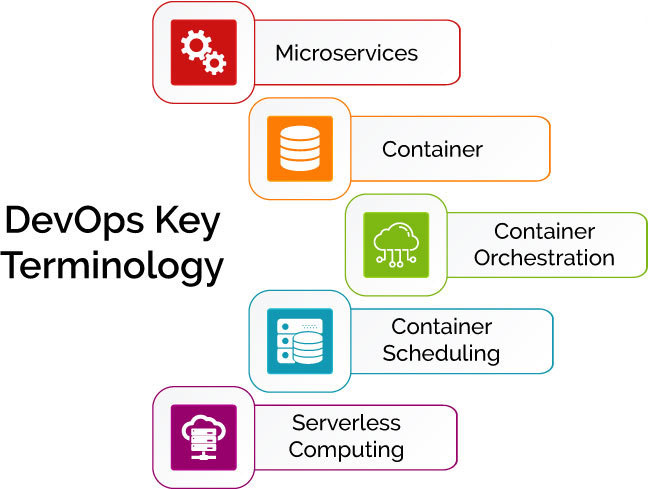
Microservices Architecture
Microservices is an architectural style of developing a complex application by dividing it into smaller modules/microservices. These Microservices are loosely coupled, deployed independently and are focused properly by small teams.
With Microservices developers can decide how to use, design, language to choose, platform to run, deploy, scale etc.
Advantages Of Microservices Architecture
-
Microservices can be developed in various programming languages.
-
Errors in any module or microservices can easily be found out, thus saves time.
-
Smaller modules or microservices are easier to manage.
-
Whenever any update required, it can be immediately pushed on that particular microservices; otherwise, the whole application needs to be updated.
-
According to client need, we can scale up and down particular microservice without affecting the other microservices.
-
It also leads to increase in productivity.
-
If anyone module goes down, the application remains largely unaffected.
Disadvantages Of Microservices Architecture
-
If an application involves the number of microservices, then managing them becomes a little bit difficult.
-
Microservices leads to more memory consumption.
-
In some cases, Testing Microservices becomes difficult.
-
In production, it also leads to complexity of deploying and managing a system comprised of different types of services.
Overview of Containers and Docker
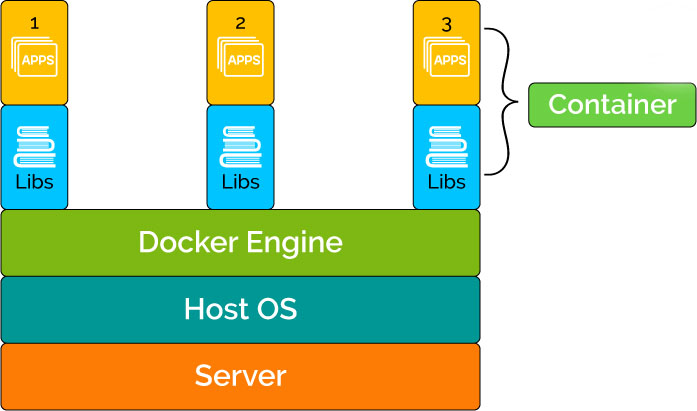
Containers create a virtualization environment that allows us to run multiple applications or operating system without interrupting each other.
With the container, we can quickly, reliably and consistently deploy our application because containers have their CPU, memory, network resources and block I/O that shares with the kernel of host operating system.
Containers are lightweight because they don’t need the extra load of a hypervisor, they can be directly run on a host machine.
Before we were facing a problem that code can easily run on developer environment but while executing it in the production environment, dependency issue occurs.
Then virtual machines came, but they were heavyweight that leads to wastage of RAM, the processor is also not utilized completely. If we need more than 50 microservices to run then, VM is not the best option.
5 Advantages Of Using Containers
-
Wastage of resources like RAM, Processor, Disc space are controlled as now there is no need to pre-locate these resources and are met according to application requirements.
-
Sharing a container is easy.
-
Docker provides a platform to manage the lifecycle of containers.
-
Containers provide consistent computation environment.
-
Containers can run separate applications within a single shared operating system.
Container Orchestration
Container Orchestration is Automated, Arrangement, Coordination, and Management of containers and the resources they consume during deployment of a multi-container packed application.
Container Orchestration Features
-
Cluster Management - Developer’s task is limited to launch a bunch of container instances and specify the functions which are needed to run. Administration of all containers is done by Orchestration.
-
Task Definitions - It allows the developer to define task where they have to specify the number of containers required for the work and their dependencies. Many tasks can be launched through single job definition.
-
Programmatic Control - With simple API calls one can register and deregister tasks, and launch and stop Docker containers.
-
Scheduling - Container scheduling deals with placing the containers from the cluster according to the resources they need and the availability of requirements.
-
Load Balancing - Helps in distributing traffic across the containers/deployment.
-
Monitoring - One can monitor CPU and memory utilization of running tasks and also gets alerted if containers need scaling.
Understanding Docker
Docker is light weighted Container that has inbuilt images and occupies very less space comparatively. But for running a Docker, we need a Linux or Ubuntu as a host machine.
Overview of Docker Hub
It's cloud-hosted service provided by Docker. Here we can upload our image or also can pull the images in public repository.
Docker Registry
Storage component for Docker images Either we can store in public repository or private repository. We are using this to integrate image storage with our in-house development workflow and also to control where images are to be stored.
Running Docker Images
Read-only template that is used to create the container. Built by Docker user and stored on Docker hub or local registry.
Docker Containers
It's runtime instance of Docker image. It's built from 1 or more images.
Hence Docker helps in achieving application issues, Application Isolation, and faster development.
You May also Love to Read Docker Overview - A Complete Guide
8 Container Orchestration Tools To Know
For Container orchestration different tools are used, few are open source tools like Kubernetes, and Docker Swarn which can be used privately, also some paid tools are there like AWS ECS from Amazon, Google Containers, and Microsoft Containers.
Some of these tools are briefly explained below -
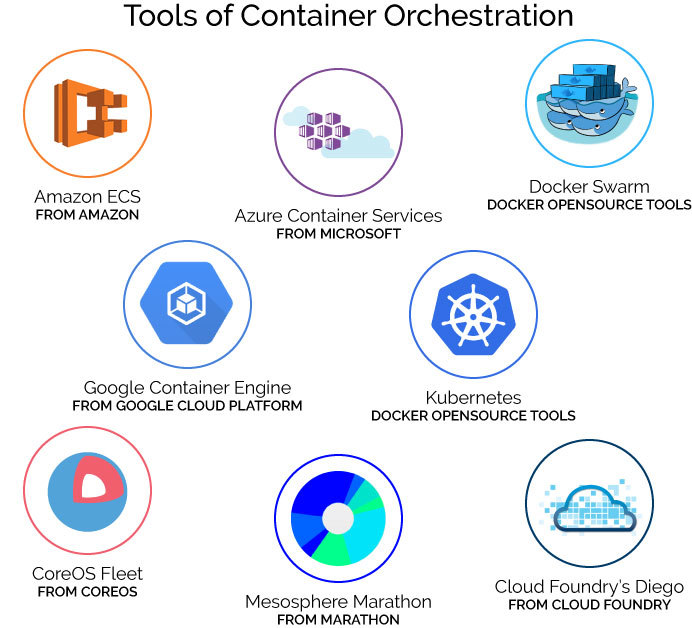
Amazon ECS - Run Containerized Applications in Production
Amazon ECS is yet another product from Amazon Web Services that provides the runtime environment for Docker Containers and provide orchestration. It allows running Dockerized applications on top of Amazon’s Infrastructure.
Azure Container Services
Azure Container Service product is by Microsoft allowing similar functionalities. It has excellent support for the .NET ecosystem.
Docker Swarm
It’s an open source tool, part of Docker’s landscape. With this tool, we can run multiple Docker engines as a single virtual Docker. This is Dockers own containers orchestration Tool. It consists of the manager and worker nodes that run different services for orchestration. Managers that distributes tasks across the cluster and worker node run containers assigned by administrators.
Google Container Engine
Google Container Engine allows us to run Docker containers on Google Cloud Platform. It schedules the containers into the cluster and manages them as per the requirements were given. It is built on the top of Kubernetes, i.e., an open source Containers Orchestration tool.
Kubernetes
Kubernetes is one of the most mature orchestration systems for Docker containers. It's an open source system used for automating the deployment and management of containerized application also according to user's need it scales the application. Hence, It provides basic mechanisms for deployment, maintenance, and scaling of applications.
CoreOS Fleet
CoreOS Fleet is a container management tool that lets you deploy Docker containers on hosts in a cluster as well as distribute services across a cluster.
Cloud Foundry’s Diego
Cloud Foundry's Diego is a container management system that combines a scheduler, runner, and health manager. It is a rewrite of the Cloud Foundry runtime.
Mesosphere Marathon
Mesosphere Marathon is a container orchestration framework for Apache Mesos that is designed to launch long-running applications. It offers key features for running applications in a clustered environment.
DevOps Open Source Tools Comparison
During Transformation Towards Agile & DevOps, DevOps needs a platform where we can define workflow with different Integrations. Implementing DevOps Culture into your workflow requires using of specialized tools.
Read more about-DevOps Tools
Container Scheduling
Container Scheduling is one of the key features of Container Orchestration. Schedule simply means optimizing, arranging and controlling the task or resources. It includes upgrades, downgrades the resources, rescheduling, placement, scaling, and replication of resources needed to run a container.
Container Scheduling also helps in two important aspects -
-
Auto-Recovery - It means to recover the unhealthy containers required for the proper working of applications.
-
Container Deployments - When a new version of task definition is uploaded, schedulers automatically stop the containers needed for the previous version and start running the new containers as defined in uploaded image. Thus allowing easy updating of containers to the latest version.
Container orchestration and container scheduling are assumed to be same, but actually, they are different.
Container Scheduling is a feature of Container Orchestration. Scheduler job is to assign work to the container and orchestration ensures the resources needed to perform the work when needed, like scheduler assigned work to do load balancing, failure recovery and scaling, then for executing these task orchestration ensures or creates the environment which of these services are available.

Continuous Monitoring and Alerting in DevOps

Monitoring refers to analyze resources and their metrics continuously like CPU, Host, Memory, Storage, Network and take decision accordingly. Like sometimes CPU Utilization goes beyond the limit then we take decision accordingly and also if the host was not working then we can replace it or troubleshoot the host.
So, Monitoring works as feedback from the production environment. By doing Monitoring of our application, we can analyze the application’s performance and usage patterns. We Do so to detect the errors and as soon as we found we can immediately correct it.
Effective monitoring is essential to allow DevOps teams to deliver at speed, get feedback from production, and increase customer's satisfaction, acquisition, and retention.
We do monitoring not only to raise our application, i.e., because we found out the out new things, new ideas, analyze the usage data, and figure out new things that can add value the application.
Effective Monitoring allows DevOps team to deliver the product on time at better speed and also important gets feedback from customers, our primary focus is towards customer satisfaction, we also focus on delivery much better than customer expectation.
We have many types of ways for monitoring our application by that we predict the application that are usage Monitoring, Availability Monitoring, Performance Monitoring etc.
Serverless Computing Architecture

Serverless Computing is a technology which allows developers to focus only on developing value-adding code and not to concentrate on provisioning or managing servers.
Serverless computing relieved developers from worrying about infrastructural and operational details like scalability, high availability, infrastructure, security etc., and allowing developers to do what they enjoy doing, i.e., writing code and creating the "next big thing” and someone else will manage and handle all the issues regarding servers and other infrastructure.
Serverless Computing is simply a building code and runs of applications without thinking about servers. “Serverless” doesn’t mean servers are no longer involved. It means the existence of servers is hidden from developers. So, with serverless computing developer shift his focus from server level to coding level.
The key benefit of serverless computing is that it encourages Microservices, i.e., dividing complex problems into smaller modules and then solving those modules.
Understanding AWS Lambda
Nowadays, AWS Lambda is the most used platform for Serverless Computing. The developer has just one task, i.e., to provide the code, rest all is taken care by AWS Lambda including managing and provisioning servers.
AWS Lambda Features For Serverless Computing -
-
It supports various languages including Node.js, Java, C+, and Python.
-
In AWS Lambda we have to pay only for our computer time and not for the time when the code is not running.
-
According to our function memory requirement, Lambda automatically allocates CPU power, network bandwidth etc. proportionally.
-
It provides continuous scaling of our application.
How Can Don Help You?
We Started transformation towards DevOps Strategy by adopting processes like Integration of DevOps Tools, Processes and Data into our work Culture. Parallelly, We Started adopting different Infrastructure architectures, Building Private Cloud, Docker, Apache Mesos, and Kubernetes.
During Transformation Towards Agile & DevOps, we realized that DevOps needs a platform where we can define workflow with different Integrations -
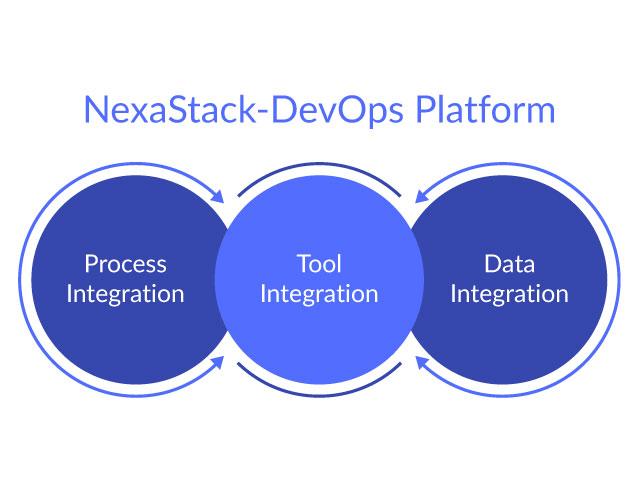
And the result which came out was NexaStack – DevOps Platform. NexaStack provides DevOps as a Service and Unified DevOps Platform for Continuous Delivery Pipeline for applications and Big Data supporting Microservices, Lambda Architecture
NexaStack DevOps Solution helps you Automate, Monitor, and Analyse Application Delivery with Continuous Container Delivery Pipeline which helps you getting more saving in the cloud.

